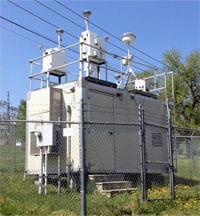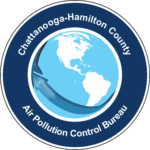Air Monitoring
Monitoring Standards
 The Bureau monitors air quality levels for Chattanooga/Hamilton County, Tennessee to ensure that our pollution levels remain in compliance with EPA’s National Ambient Air Quality Standards (NAAQS) for fine particulate matter that is less than 2.5 micrograms per cubic meter (µg/m3) and for ozone.
The Bureau monitors air quality levels for Chattanooga/Hamilton County, Tennessee to ensure that our pollution levels remain in compliance with EPA’s National Ambient Air Quality Standards (NAAQS) for fine particulate matter that is less than 2.5 micrograms per cubic meter (µg/m3) and for ozone.
The particulate standard requires the monitoring of PM 2.5 and is set at a concentration of 9 (µg/m3), with a 24-hour standard set at 35 µg/m3. The standard for ozone is based on an 8-hour standard of 70 parts per billion. These standards are set by the EPA based on numerous health studies showing adverse effects from chronic exposure to these pollutants.
Criteria Pollutants
 The federal government set standards for six commom outdoor air pollutants, also known as criteria pollutants: carbon monoxide, nitrogen dioxide, sulfur dioxide, ozone, particulate matter, and lead. These pollutants are considered to be the most widespread nationally and the most immediately dangerous to human health, the environment, and can damage property. Communities are required to meet the federal health standards for all six of the criteria pollutants, but are only required to continually monitor for those which appear to need testing in that area as indicated by historical data, trends, and known emissions.
The federal government set standards for six commom outdoor air pollutants, also known as criteria pollutants: carbon monoxide, nitrogen dioxide, sulfur dioxide, ozone, particulate matter, and lead. These pollutants are considered to be the most widespread nationally and the most immediately dangerous to human health, the environment, and can damage property. Communities are required to meet the federal health standards for all six of the criteria pollutants, but are only required to continually monitor for those which appear to need testing in that area as indicated by historical data, trends, and known emissions.
Chattanooga is currently required to monitor for ozone and particulate matter, and maintains a network of monitoring sites throughout the county for this purpose.
The Bureau uses the data from the monitoring sites to generate a Daily Air Quality Report, based on EPA’s Air Quality Index (AQI). The AQI is a scale designed by the EPA to standardize the method for reporting air quality nationwide. In Hamilton County, the daily air quality level is determined by the highest pollutant for that day.
Get more information on the Daily Air Quality Report.
Natural Pollutants
 Air pollution does not consist entirely of man-made substances. Many pollutants are released directly from natural sources, including plants, and some pose as much of a health hazard as man-made substances. These “natural” pollutants include pollen and mold spores. They are also know as aeroallergens because they are airborne substances that cause an allergic reaction. Some of the reactions can include itchy, watery eyes, sneezing, and wheezing.
Air pollution does not consist entirely of man-made substances. Many pollutants are released directly from natural sources, including plants, and some pose as much of a health hazard as man-made substances. These “natural” pollutants include pollen and mold spores. They are also know as aeroallergens because they are airborne substances that cause an allergic reaction. Some of the reactions can include itchy, watery eyes, sneezing, and wheezing.

